Efficient cooling systems play a pivotal role in the sustainable operation of data centers, where vast amounts of computing equipment generate substantial heat. As data centers continue to expand globally to meet the demands of an increasingly digital world, the energy consumption associated with cooling becomes a critical concern.
Balancing the need for effective cooling with minimizing power consumption is essential for both economic and environmental reasons. In this context, exploring and implementing energy-efficient cooling solutions emerges as a pressing priority for data center operators and environmental advocates alike.
This article delves into the challenges posed by traditional cooling methods, outlines strategies for reducing power consumption, highlights the benefits of energy-efficient cooling systems, and examines real-world examples of successful implementations.
Current Challenges in Data Center Cooling:
Data centers face significant challenges in maintaining optimal temperatures for their equipment while minimizing energy consumption. Some of the key challenges include:
- High Power Consumption: Traditional cooling systems, such as air conditioning units, can consume a substantial amount of electricity. As data centers grow in size and capacity to handle increasing workloads, the energy demand for cooling escalates, leading to higher operational costs and environmental impact.
- Inefficient Airflow Management: In many data centers, inefficient airflow management results in hot spots and uneven cooling distribution. This inefficiency not only compromises the performance and lifespan of the equipment but also requires additional energy to maintain stable temperatures.
- Environmental Impact: The energy-intensive nature of cooling systems contributes to the carbon footprint of data centers, impacting the environment. As concerns about climate change intensify, there is a growing urgency to adopt more sustainable cooling practices to reduce greenhouse gas emissions.
- Scalability Issues: As data centers expand and upgrade their infrastructure to meet growing demands, scalability becomes a challenge for traditional cooling solutions. Conventional systems may struggle to accommodate the increased heat load efficiently, leading to performance bottlenecks and higher energy consumption.
Strategies for Reducing Power Consumption:
To tackle the challenges of high energy consumption in data center cooling, several strategies can be employed:
- Utilization of Advanced Cooling Technologies:
- Free Cooling: Leveraging natural cooling sources, such as outside air or water, during favorable environmental conditions to reduce reliance on mechanical cooling systems.
- Adiabatic Cooling: Implementing evaporative cooling techniques that use water evaporation to lower air temperature without the need for compressor-based cooling.
- Variable Speed Fans: Installing fans with variable speed controls to adjust airflow dynamically based on real-time cooling demands, improving energy efficiency.
- Optimization of Airflow Management:
- Hot Aisle/Cold Aisle Containment: Implementing containment systems to separate hot and cold air streams, reducing mixing and improving airflow efficiency.
- Blanking Panels: Installing blanking panels in server racks to prevent recirculation of hot air and optimize airflow pathways, enhancing cooling effectiveness.
- Airflow Modeling: Utilizing computational fluid dynamics (CFD) simulations to analyze airflow patterns and optimize data center layout for improved cooling efficiency.
- Implementation of Liquid Cooling Solutions:
- Direct-to-Chip Liquid Cooling: Deploying liquid cooling solutions that directly cool individual server components, such as CPUs and GPUs, to dissipate heat more effectively than air-based cooling methods.
- Immersion Cooling: Submerging servers or entire racks in dielectric fluids to absorb heat directly from components, offering highly efficient cooling with minimal energy consumption.
Benefits of Energy-Efficient Cooling Systems:
Implementing energy-efficient cooling systems in data centers offers a range of advantages, including:
- Reduced Operational Costs:
- Lower Energy Consumption: Energy-efficient cooling technologies, such as free cooling and variable speed fans, consume less electricity compared to traditional cooling methods, leading to decreased operational expenses.
- Cost Savings: By reducing power consumption, data center operators can lower utility bills and achieve long-term cost savings, improving the overall financial sustainability of their operations.
- Lower Environmental Footprint:
- Decreased Carbon Emissions: Energy-efficient cooling systems produce fewer greenhouse gas emissions due to reduced energy consumption, contributing to environmental sustainability and helping mitigate climate change.
- Environmental Compliance: Meeting or exceeding regulatory requirements for energy efficiency and environmental stewardship demonstrates corporate responsibility and enhances the reputation of data center operators.
- Enhanced Reliability and Performance:
- Improved Equipment Lifespan: By maintaining optimal operating temperatures and reducing thermal stress on hardware components, energy-efficient cooling systems can extend the lifespan of servers and other critical infrastructure, minimizing downtime and replacement costs.
- Enhanced Performance: Stable and efficient cooling ensures consistent performance of IT equipment, preventing overheating-related issues that can degrade system performance and compromise data integrity.
- Scalability and Flexibility:
- Adaptability to Growth: Energy-efficient cooling solutions are often more scalable and adaptable to accommodate future expansion and increased heat loads, providing flexibility for data center scalability without compromising efficiency.
- Compatibility with Emerging Technologies: As data center technologies evolve, energy-efficient cooling systems offer compatibility with advanced hardware architectures, such as high-density computing and AI accelerators, facilitating innovation and growth.
Conclusion:
In conclusion, energy-efficient cooling systems present a compelling solution for addressing the challenges faced by data centers. By reducing operational costs, minimizing environmental impact, and enhancing reliability, these systems offer tangible benefits for data center operators. Moreover, their scalability and compatibility with emerging technologies ensure long-term viability in a rapidly evolving landscape. Embracing energy-efficient cooling not only fosters sustainability but also drives competitiveness and innovation, positioning data centers for success in the digital age.












